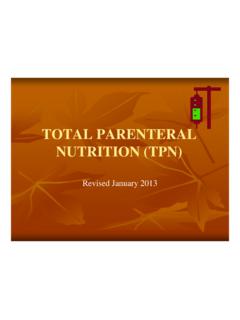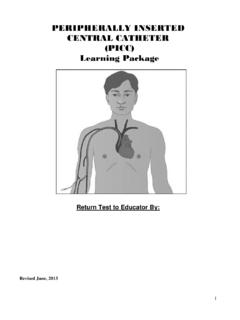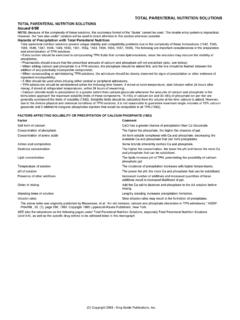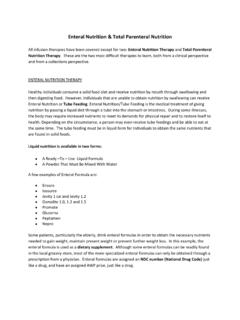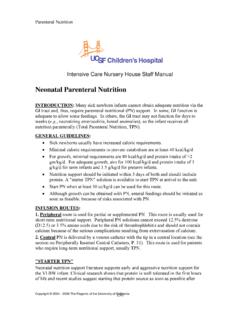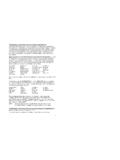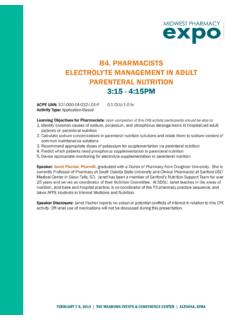Transcription of CARE OF THE PATIENT RECEIVING TOTAL …
1 1 CARE OF THE PATIENT RECEIVING TOTAL parenteral nutrition (TPN) General Surgery North York General Hospital Revised July 2013. 2T A B L E O F C O N T E N T S Introduction 3 Learning Objectives 3 Competency Process 3 What is TPN? 4 Indications for TPN administration 4 Composition of TPN solutions 5 Access routes for TPN administration 6 TPN Administration 8 Fluid management with TPN 9 Monitoring during TPN administration 10 Complications associated with TPN therapy 14 Documentation of TPN administration 18 References 26 TPN Post-Test 27 3 INTRODUCTION TOTAL parenteral nutrition (TPN) is the provision of intravenous nutrients to patients whose gastrointestinal (GI) tract is not functioning or cannot be accessed and to patients whose nutritional needs cannot be met with oral diets or enteral feeding.
2 The PATIENT receives a combination of nutrients- crystalline amino acids, dextrose, electrolytes, vitamins, minerals, trace elements and lipid/fat emulsion administered intravenously. Once limited to critical care areas, TPN is now present on post surgical floors and medical units, when feeding by mouth is not possible, when a person's digestive system cannot absorb nutrients due to chronic disease, or, alternatively, if a person's nutritional requirements cannot be met by enteral feeding (tube feeding) and/or through oral diet. Caring for patients RECEIVING TPN requires additional knowledge and skill. This learning package has been developed to provide information to nursing staff caring for patients RECEIVING TPN for nutritional support. LEARNING OBJECTIVES The Registered Nurse/Registered Practical Nurse will be able to: 1. Define the term TPN and state indications for administration. 2. Describe the composition of the TPN solution and the rationales for each solution.
3 3. Identify the access routes for administration of TPN. 4. Describe the assessments involved for patients on TPN. 5. State how to administer TPN and monitor the delivery of TPN. 6. State the complications associated with TPN administration. 7. State how to document TPN administration interventions. 8. Understand the collaborative multidisciplinary approach of TPN therapy. COMPETENCY PROCESS 1) Review of self-directed learning package. 2) Complete and obtain a minimum of 80% on the TPN post-test. 3) Attend a lecture/review session with CNE and perform TPN administration competency in simulated environment. 4) Perform one return demonstration of TPN administration on actual PATIENT . 4 WHAT IS TPN? TOTAL parental nutrition (TPN) is the practice of nourishing a PATIENT intravenously, bypassing the usual process of eating and digestion. It is a form of specialized nutrition , including amino acids, dextrose, fat emulsion, vitamins, minerals and trace elements given intravenously.
4 The TPN solution is osmotically active and must be administered carefully to prevent trauma to the vascular portal of entry. It is administered intravenously and can be administered through a peripherally inserted central catheter (PICC), a central venous line (CVC) or a large peripheral line. In order to administer it carefully, TPN is ALWAYS administered through an infusion pump. The sterile bags of nutrients are infused continuously through the pump over a 12 hour or 24 hour period to prevent vascular trauma and metabolic instability. INDICATIONS FOR TPN ADMINISTRATION TPN is administered for various reasons and over varying periods of times. TPN support is prescribed if there is intolerance to oral intake or enteral feeds and if the PATIENT is NPO for an extended period of time. This is usually 3 days if the PATIENT is moderately to severely malnourished or 7 days if the PATIENT is well nourished or mildly malnourished.
5 Short-term TPN (7 to 10 days) or long-term TPN (>10 days) is used to treat patients whose GI tract is not functioning or not accessible for various reasons. Below is a chart which identifies the conditions where TPN administration is commonly prescribed. Chart 1: Indications for TPN administration PHYSIOLOGICAL CONDITION CLINICAL MANIFESTATION Non functional GI tract Massive small bowel resection/ GI surgery Paralytic ileus Small bowel ileus (dilated bowel with air/fluid levels on CT scan) Intestinal obstruction Trauma to abdomen, head , neck Severe malabsorption Intolerance to enteral feeding (protracted nausea/vomiting) Bowel infarction/bowel ischemia Chemotherapy, radiation therapy, bone marrow transplant High output small bowel fistula >500ml/d Mechanical small bowel obstruction 5 Extended bowel rest Enterocutaneous fistula Inflammatory bowel disease exacerbation Severe diarrhea Moderate to severe pancreatitis Pre Operative TPN Preoperative bowel rest Treatment for comorbid severe malnutrition in patients with non- functioning GI tracts Severe catabolic patients when GI tract non-usable for more than 3 to 5 days COMPOSITION OF TPN SOLUTIONS TPN is specialized nutrition including amino acids, dextrose, fat emulsions, vitamins, minerals and trace elements prepared in a sterile bag for intravenous administration.
6 The TPN prescription is made up of two components: amino acid/ dextrose solution and lipid emulsion. TPN is ordered by the physician depending on the PATIENT s clinical history and current metabolic needs. Amino acids/ dextrose solution ( Travasol) is prepared in a 1000 ml or 2000 ml bag [may appear yellow/clear] depending on the ordered rate for the 24 hour period. Bags contain amino acids, dextrose, minerals, trace elements and multivitamins [which turns the bag yellow]. The rate of infusion may be adjusted gradually by the physician or dietitian to prevent metabolic and electrolyte abnormalities. The amino acids/ dextrose solution is ordered, based on the PATIENT s clinical presentation and blood work, to support their metabolic needs. Travasol solution is compounded/manufactured by Pharmacy according to the physician s orders; in consultation with the dietician, who has completed a nutritional assessment of the PATIENT .
7 The PATIENT -specific solution dispensed is either a standard solution [pre-made] or a custom solution [all additives are customized as per the dietician s recommendations and the physician s orders]. Travasol has various concentrations and must be administered in a large vein to prevent vascular trauma. High concentrations [>10% dextrose] and amino acid can safely be administered in large veins through PICC and CVC, because the blood volume present dilutes the solution. Weaker concentrations [< or = 10% dextrose] are appropriate for small peripheral veins for the same reason. The physician will order TPN via a PICC or CVC line if: The PATIENT has poor peripheral access High concentration TPN solution is ordered [>10% dextrose]. 6 The ingredients are individually listed on the bag and must be verified with the physician s order on the eMAR by the nurse hanging the bag, following the 8 rights of medication administration.
8 In addition the bag will be scanned with Caremobile (see pages 21 & 22). Lipid emulsions are prepared in 100 ml or 250 ml bags and contains essential fatty acids [appears milky]. Lipid emulsions are ordered to prevent fatty acid deficiency that causes scaly dermatitis, alopecia, thrombocytopenia, and growth retardation in children. At NYGH, lipids are dispensed in 20% solutions and are commonly run over a 12 hour period only. Remove the bag from the sealed package, verify the physician s order on the eMAR, including the rate of administration, fill in the label provided including the rate, date/time and your initials. The bag will also be scanned with the Caremobile (see pages 21 & 22). ACCESS ROUTES FOR TPN ADMINISTRATION TPN solutions must be carefully administered intravenously because it is osmotically active and can cause trauma to the vascular portal of entry. For this reason, TPN is best administered through a large vein and at NYGH; the preferred route for administration is through a PICC.
9 A PICC is a peripherally inserted central catheter which is inserted into the basilic, brachial or cephalic veins in the upper arm. A CVC may also be used for TPN administration. A CVC is a multi-lumen central venous catheter inserted into the subclavian and internal jugular vein. Alternately, if neither site is available, a large peripheral site maybe used to administer TPN. If a peripheral IV is to be used, only dilute concentrations of TPN [< or =10% dextrose] can be administered. Once an intravenous line is used for TPN nothing else can be administered through that line. Large venous catheters such as PICC and CVC lines are inserted by physicians, radiologists or certified RNs in the radiology department ONLY. Radiology is opened from Mondays to Fridays 0800 to 1600 hours. If an order for TPN administration occurs outside of these hours [ evenings, weekends and holidays], a large peripheral IV may be used to start dilute concentrations of TPN instead.
10 7 Below is a chart which summarizes the access routes and TPN administration plan of care. Chart 2: Access routes and TPN administration plan of care ACCESS TYPE PLAN OF CARE PICC (PERIPHERALLY INSERTED CENTRAL VENOUS CATHETER) Catheterization of central venous system through the basilic or cephalic vein [in the arm], advanced into basilica or cephalic vein, then threaded up toward the heart into the right subclavian vein Inserted when TPN is expected to run > 1 week in patients who are at high risk for phlebitis CVC (CENTRAL VENOUS CATHETER) Catheterization of subclavian or internal jugular vein Catheter related complications: sepsis, pneumothorax, embolism Solutions to infuse- either central or peripheral solutions Inserted when peripheral veins are unsuitable PERIPHERAL INTRAVENOUS CATHETER Uses arm veins Solutions to infuse only < or =10% dextrose solution -consider phlebitis of vein Inserted when TPN expected to run less than 2 weeks & peripheral access is reasonable 8 Below is a chart which summarizes the recommended entry sites and concentrations of TPN solutions for administration.
